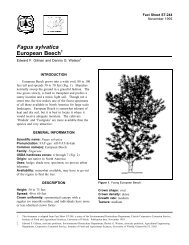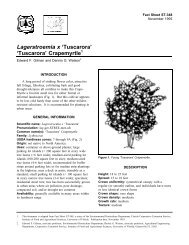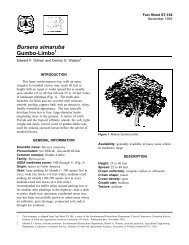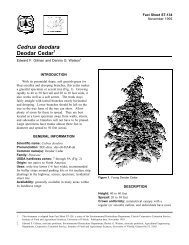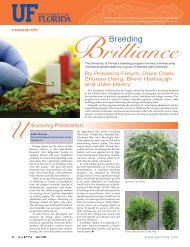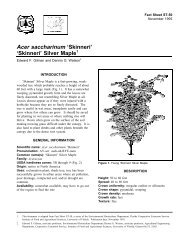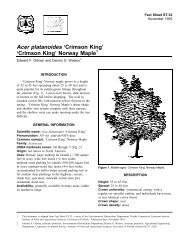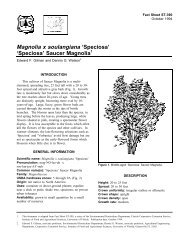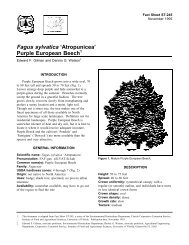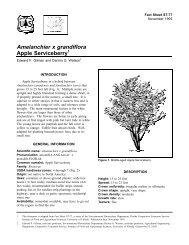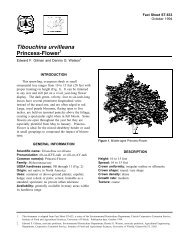Jatropha integerrima Peregrina - Environmental Horticulture ...
Jatropha integerrima Peregrina - Environmental Horticulture ...
Jatropha integerrima Peregrina - Environmental Horticulture ...
You also want an ePaper? Increase the reach of your titles
YUMPU automatically turns print PDFs into web optimized ePapers that Google loves.
<strong>Jatropha</strong> <strong>integerrima</strong><br />
<strong>Peregrina</strong> 1<br />
Edward F. Gilman and Dennis G. Watson 2<br />
INTRODUCTION<br />
This slender-stemmed, multi-trunked tropical<br />
evergreen tree or large shrub, a native of Cuba,<br />
reaches 15 feet in height with an equal spread, and has<br />
unusual seven-inch-long leaves varying in shape from<br />
oblong, fiddle-shaped, or even-lobed (Fig. 1). The<br />
one-inch-wide red flowers are produced year-round in<br />
beautiful clusters held upright above the foliage and<br />
helps make Fire-cracker an interesting specimen plant.<br />
The seed capsules which follow hold several smooth,<br />
speckled, and toxic seeds, a fact which must be<br />
considered when placing this plant in the landscape; it<br />
should be kept out of the reach of children.<br />
GENERAL INFORMATION<br />
Scientific name: <strong>Jatropha</strong> <strong>integerrima</strong><br />
Pronunciation: jat-ROE-fuh in-teh-GAIR-rih-muh<br />
Common name(s): <strong>Peregrina</strong>, Fire-Cracker<br />
Family: Euphorbiaceae<br />
USDA hardiness zones: 10B through 11 (Fig. 2)<br />
Origin: not native to North America<br />
Uses: container or above-ground planter;<br />
recommended for buffer strips around parking lots or<br />
for median strip plantings in the highway; near a deck<br />
or patio; trainable as a standard; specimen; no proven<br />
urban tolerance<br />
Availability: generally available in many areas within<br />
its hardiness range<br />
Figure 1. Middle-aged <strong>Peregrina</strong>.<br />
DESCRIPTION<br />
Fact Sheet ST-319<br />
November 1993<br />
Height: 10 to 15 feet<br />
Spread: 10 to 15 feet<br />
Crown uniformity: symmetrical canopy with a<br />
regular (or smooth) outline, and individuals have more<br />
or less identical crown forms<br />
Crown shape: round; vase shape<br />
Crown density: open<br />
Growth rate: medium<br />
Texture: medium<br />
Foliage<br />
Leaf arrangement: alternate (Fig. 3)<br />
Leaf type: simple<br />
Leaf margin: lobed<br />
Leaf shape: oblong; obovate<br />
1. This document is adapted from Fact Sheet ST-319, a series of the <strong>Environmental</strong> <strong>Horticulture</strong> Department, Florida Cooperative Extension Service,<br />
Institute of Food and Agricultural Sciences, University of Florida. Publication date: November 1993.<br />
2. Edward F. Gilman, associate professor, <strong>Environmental</strong> <strong>Horticulture</strong> Department; Dennis G. Watson, associate professor, Agricultural Engineering<br />
Department, Cooperative Extension Service, Institute of Food and Agricultural Sciences, University of Florida, Gainesville FL 32611.
<strong>Jatropha</strong> <strong>integerrima</strong> -- <strong>Peregrina</strong> Page 2<br />
Figure 2. Shaded area represents potential planting range.<br />
Leaf venation: pinnate<br />
Leaf type and persistence: broadleaf evergreen;<br />
evergreen<br />
Leaf blade length: 4 to 8 inches<br />
Leaf color: green<br />
Fall color: no fall color change<br />
Fall characteristic: not showy<br />
Flower<br />
Flower color: red<br />
Flower characteristics: showy; year round flowering<br />
Fruit<br />
Fruit shape: oval<br />
Fruit length: .5 to 1 inch<br />
Fruit characteristics: does not attract wildlife;<br />
inconspicuous and not showy; no significant litter<br />
problem<br />
Trunk and Branches<br />
Trunk/bark/branches: bark is thin and easily<br />
damaged from mechanical impact; droop as the tree<br />
grows, and will require pruning for vehicular or<br />
pedestrian clearance beneath the canopy; routinely<br />
grown with, or trainable to be grown with, multiple<br />
trunks; not particularly showy; tree wants to grow with<br />
several trunks but can be trained to grow with a single<br />
trunk; no thorns<br />
Pruning requirement: requires pruning to develop<br />
strong structure<br />
Breakage: resistant<br />
Current year twig color: brown<br />
Current year twig thickness: medium<br />
Culture<br />
Light requirement: tree grows in part shade/part sun;<br />
tree grows in full sun<br />
Soil tolerances: clay; loam; sand; acidic; alkaline;<br />
well-drained<br />
Drought tolerance: moderate<br />
Aerosol salt tolerance: moderate
<strong>Jatropha</strong> <strong>integerrima</strong> -- <strong>Peregrina</strong> Page 3<br />
Figure 3. Foliage of <strong>Peregrina</strong>.<br />
Other<br />
Roots: surface roots are usually not a problem<br />
Winter interest: tree has winter interest due to<br />
unusual form, nice persistent fruits, showy winter<br />
trunk, or winter flowers<br />
Outstanding tree: tree has outstanding ornamental<br />
features and could be planted more<br />
Invasive potential: little, if any, potential at this time<br />
Pest resistance: long-term health usually not<br />
affected by pests<br />
USE AND MANAGEMENT<br />
<strong>Jatropha</strong> makes a delightful red-flowered accent in<br />
a shrub border planted to attract attention to an area.<br />
It flowers nearly year round and so is quite popular as<br />
a patio tree or garden accent. Multiple trunks and<br />
stems originate near the ground forming a<br />
symmetrical, weeping clump of thinly-clothed<br />
branches. The tree can be staked and trained to grow<br />
with one trunk for two or three feet. This is a nice<br />
way to display the plant as an accent or specimen. Do<br />
not expect this small tree to provide shade, but it will<br />
attract hummingbirds and butterflies.<br />
<strong>Peregrina</strong> should be grown in full sun or partial<br />
shade on well-drained soil. Full sun plants flower<br />
best. It is not salt-tolerant.<br />
There is a pink-flowered form available at some<br />
nurseries.<br />
Propagation is by seed or cuttings.<br />
Pests and Diseases<br />
No pests or diseases are of major concern but<br />
occasionally bothered by mites, scales, and superficial<br />
leaf miner.



